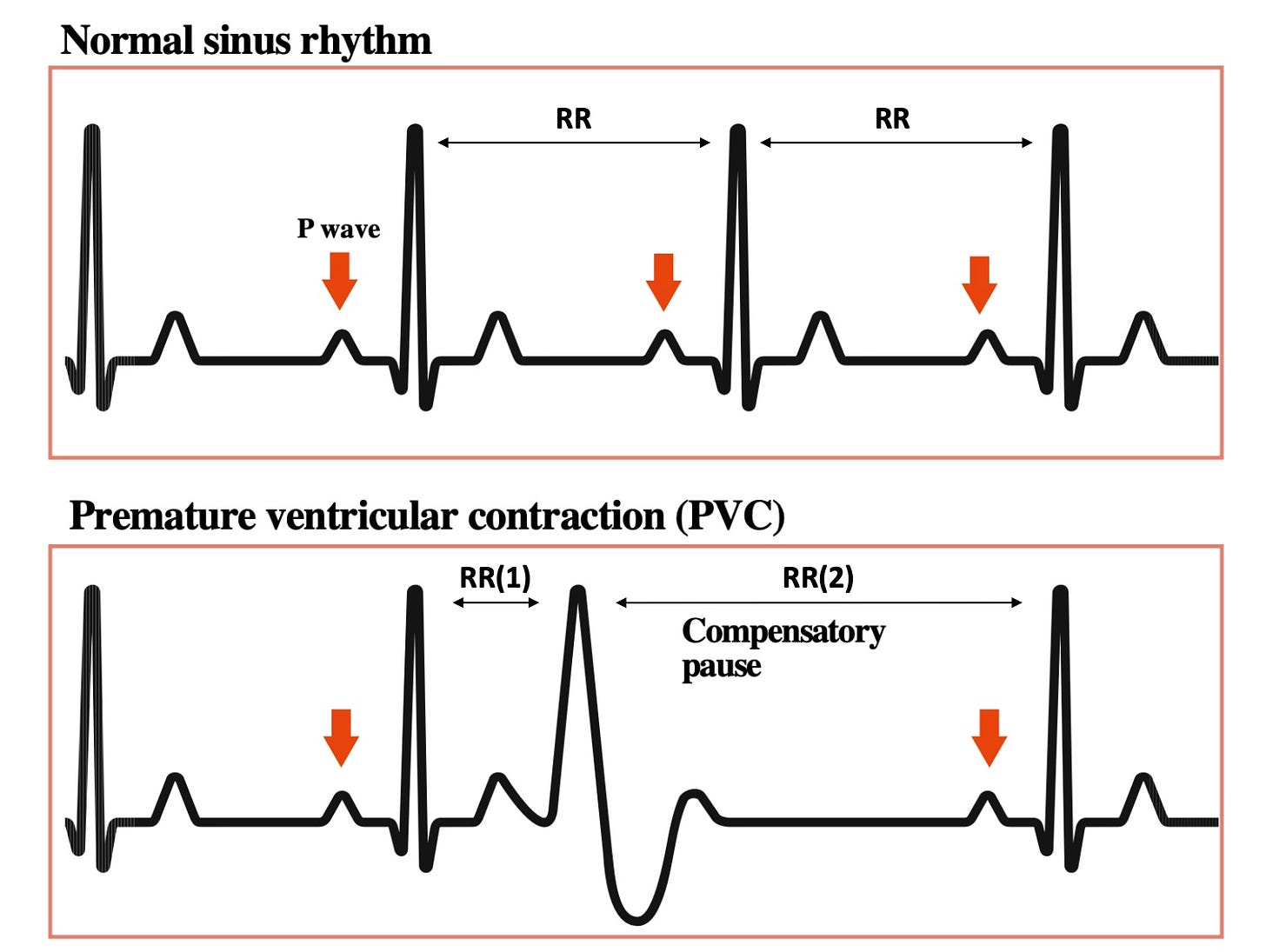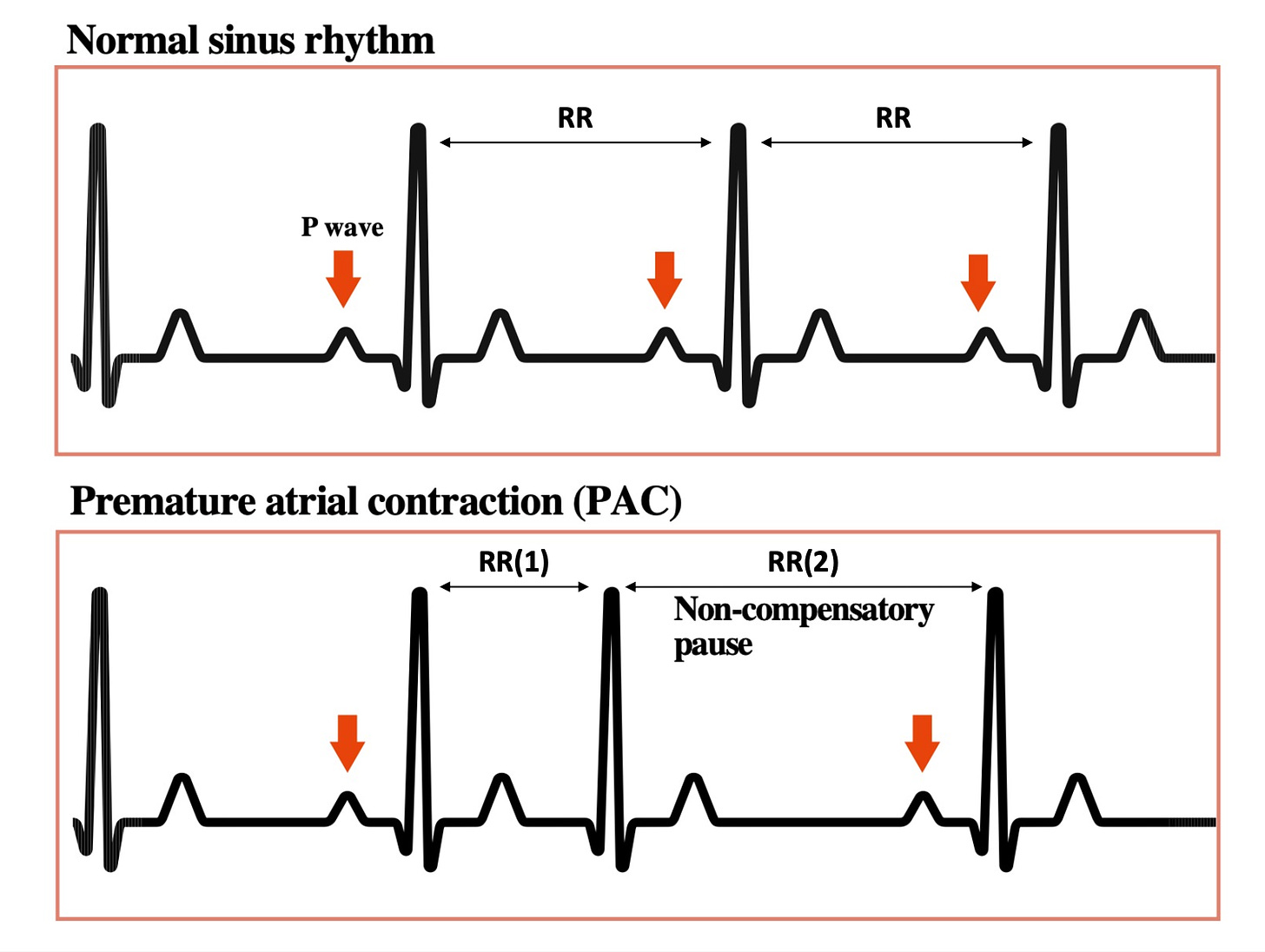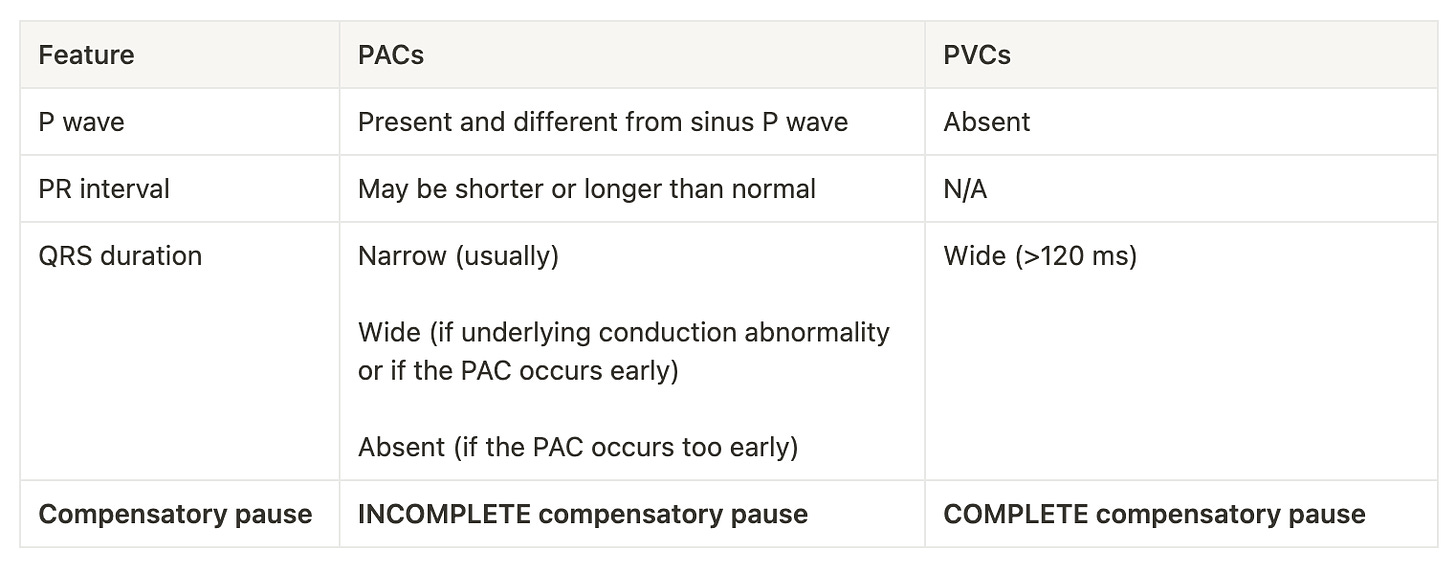In my previous post, I posed a question for you:
What is the compensatory pause, and how is it different between PACs and PVCs?
This is something that most people don’t know when trying to differentiate between premature atrial complexes (PACs) and premature ventricular complexes (PVCs).
Knowing what the compensatory pause is and how it differs between PACs and PVCs will take your ECG interpretation skills to the next level!
The compensatory pause
The compensatory pause is the period from the premature complex to the next normal complex (that long pause, yes).
It is the reason why you feel your heart “skipping a beat” when you are asked to prescribe laxatives at 03:00 in the morning…
During the compensatory pause, the heart fills with an unusually high volume of blood due to the pause’s longer duration. This excess blood is then ejected at the next beat, creating the sensation of a "pounding".
The compensatory pause in PVCs
A PVC occurs when a focus from the ventricles fires earlier than usual and depolarises the rest of the ventricular myocardium.
Meanwhile, the sinoatrial (SA) node continues to fire in the atria at its regular pace, but the electrical signal does not travel to the ventricles because they are in a refractory state (having just been depolarised by the PVC). Similarly, the impulse from the PVC doesn’t travel to the atria, as they are refractory from having been depolarised by the SA node.
Therefore, the next time the SA node fires (after the PVC), it will be at the same time it would have fired if the PVC never occurred.
So what will I see on the ECG:
If you take the RR interval between two normal beats and the RR interval from the prior-to-the-PVC complex and the PVC (which we'll call RR(1)), and from the PVC to the normal beat after the PVC (which we'll call RR(2)), you will see that:
RR(1) + RR(2) = 2 x RR
1Compensatory pause
When this phenomenon is present (i.e. RR(1) + RR(2) = 2 x RR), then we say that a compensatory pause exists.
The compensatory pause in PACs
In contrast to PVCs, PACs originate from the atria. Therefore, they depolarise the atrial muscle and cause the SA node to reset.
So the next normal beat will actually occur before the expected one if the PACs hadn’t happened in the first place.
So what will I see on the ECG:
This time, you will something like this happening:
RR(1) + RR(2) < 2 x RR
2Non-compensatory pause (or incomplete compensatory pause)
In this case, we say that an incomplete compensatory pause (or a non-compensatory pause) exists.
To summarise everything we have learnt about premature complexes…
The table below summarises what we have learnt from this and the previous article:
There are exceptions, though…
These are the most common occurrences, although there are exceptions, such as PVCs with a non-compensatory pause and interpolated PVCs. Since these are exceptions to the rule, they will not be discussed here.
However, if you are interested in learning more, please leave a comment or get in touch.
Question for you
What are escape beats, and how are they different from premature complexes? Leave a comment or send me an email with your answer!
I hope you had a wonderful weekend and wish you an even better week! If you have any questions or feedback, please leave a comment.
If you know anyone who could benefit from this newsletter, please share it with them.
Disclaimer
The information in this newsletter is for educational purposes only and is not intended to substitute for professional medical advice, diagnosis, or treatment. The content is based on general ECG interpretation principles and may not apply to every patient case. Readers should always seek the advice of a qualified healthcare provider with any questions or concerns they may have regarding a medical condition. The author and publisher of this newsletter are not liable for any damages or injuries arising from the use or misuse of the information presented in this newsletter. While every effort has been made to ensure the accuracy and completeness of the information provided, the author and publisher make no warranties or representations, expressed or implied, about the accuracy, reliability, or suitability of the content. The author and publisher disclaim any liability or responsibility for any errors or omissions in the content or for any loss or damage of any kind arising directly or indirectly from the use or reliance on the information provided.
Attribution: YitzhakNat, CC BY-SA 4.0 https://creativecommons.org/licenses/by-sa/4.0, via Wikimedia Commons
Changes have been made to the image, including cropping and removal of the part showing the PAC. The relevant RR, RR(1), and RR(2) intervals have been added to the image. This modified image is licensed under the same license as the original: the Creative Commons Attribution-Share Alike 4.0 International license.
Attribution: YitzhakNat, CC BY-SA 4.0 https://creativecommons.org/licenses/by-sa/4.0, via Wikimedia Commons
Changes have been made to the image, including cropping and removal of the part showing the PVC. The relevant RR, RR(1), and RR(2) intervals have been added to the image. This modified image is licensed under the same license as the original: the Creative Commons Attribution-Share Alike 4.0 International license.






